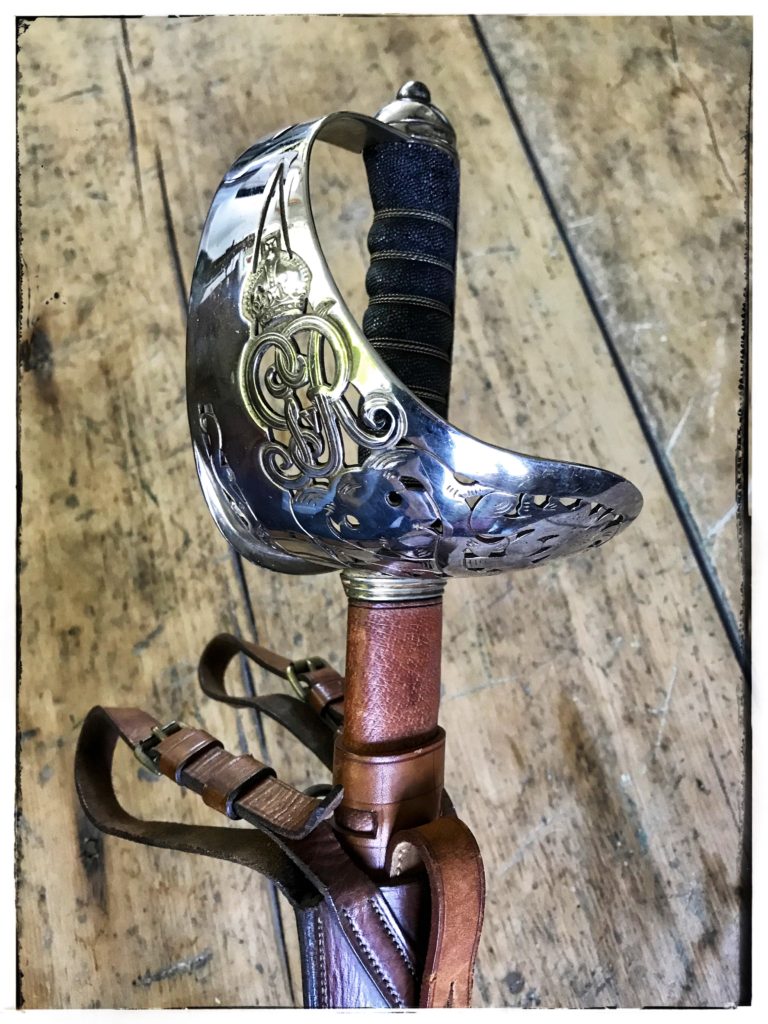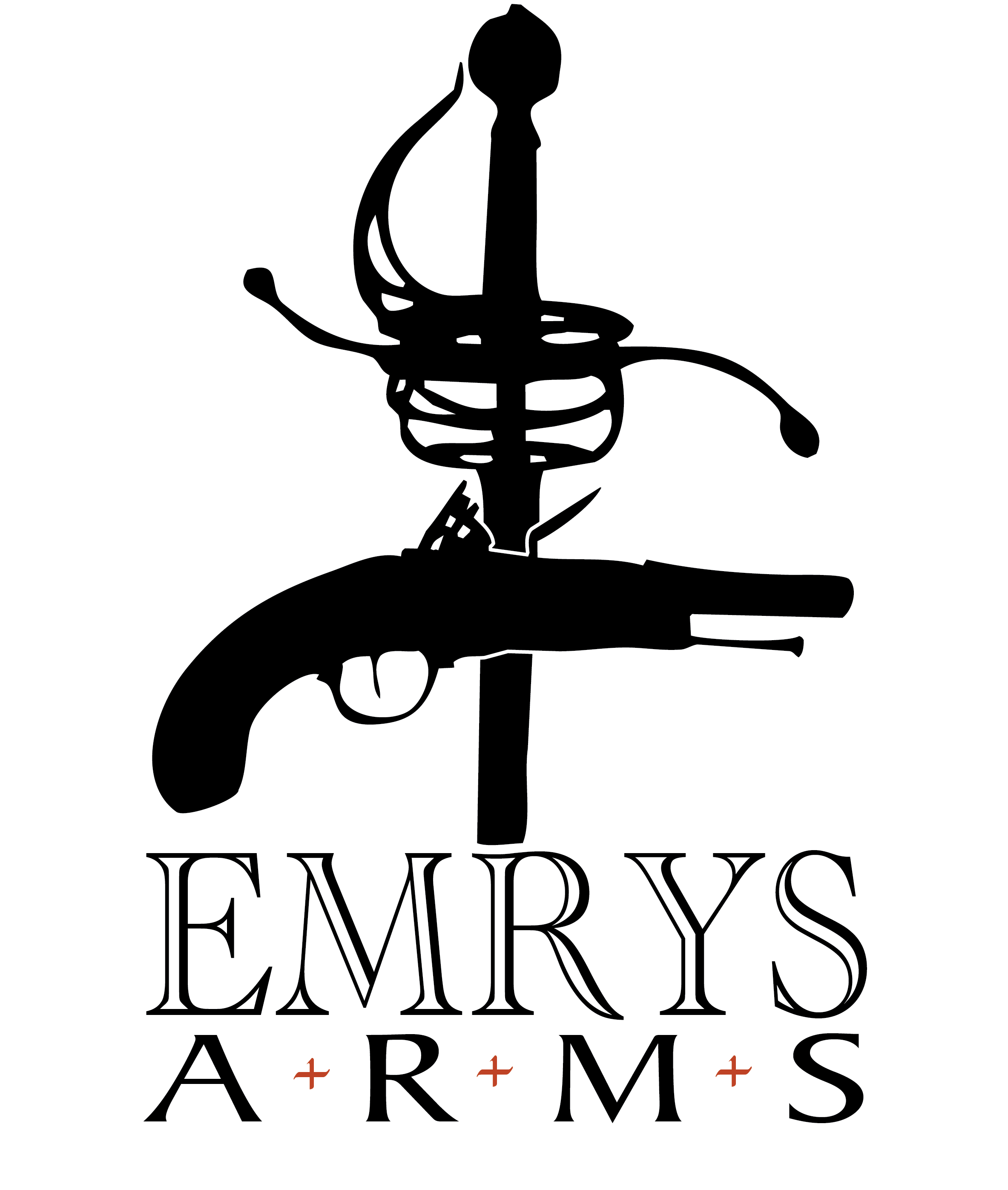| Collection #: | 2020.015 |
|---|---|
| Type: | Infantry Officer |
| Nationality: | British |
| Pattern: | 1897 |
| Date: | 1910 - 1936 |
| Hilt: | Plated Steel |
| Blade Length: | 82.6cm (32.5") |
| Blade Width: | 2.7cm (1 1/16") |
| Overall Length: | 98cm (38 5/8") |
| Maker: | Henry Wilkinson ~ Pall Mall ~ London |
| Retailer: | R.J. Inglis Ltd. ~ Montreal & Winnipeg |

A very nice example of a British (or Commonwealth) Infantry Officers’ Pattern 1897 sword. Except for some speckling on the inside of the guard, I would be tempted to say this example is in near mint condition. The only clues that this piece gives away as to its exact date is the royal cypher of King George V which places it somewhere between 1910 and 1936. By this time in history, the sword had mostly fallen out of use except on the parade square.
This is the final pattern of sword for the British infantry and is still in use today. To fully appreciate it, however, we need to first look at its brief predecessor, the 1895 pattern. With the introduction of a new blade style in 1891/92, it was time for the aging hilt style of the 1845 pattern (or technically the 1845/54 or 1854 pattern – depending which author you read) to evolve as well. “In 1895, in the form of a plated steel, three-quarter basket hilt, in a scroll pattern made up of pierced strapwork incorporating a crown and royal cypher, [this was achieved]. It gave excellent protection to the hand although a critic might claim that the pierced strapwork might still allow a sword or lance point to penetrate. Nevertheless, taken as a whole, the Pattern 1895 sword, with it’s excellent guard and its wicked, thrusting blade, was unquestionably the best fighting sword ever prescribed for the infantry officers of the Army, and its theoretical excellence was confirmed in practice.”
The 1895 pattern only lasted a couple of years before a modification was adopted which saw the edge of the steel guard turned down to prevent the fraying of the uniform. This seems to have been a common theme throughout history regarding the adoption of new swords in the British Army and Cavalry – the adjustment of the guard to prevent fraying and wear on the uniform. The rigid shell guard version of the 1786 infantry pattern evolving into the 1796 infantry pattern with one shell guard folding down. Then the 1822 infantry pattern (replacing the 1796 pattern) with folding guard, but then losing that folding guard in the modification of 1854. The 1864 cavalry pattern introduced a new design to the cavalry, which eventually resulted in a modification to roll down the edges of the guard in the 1882 pattern (see the 1890 pattern as I do not own an 1882 pattern yet, but the guard is essentially the same). Finally we have an alteration of the guard a British regulation sword one last time with the 1895 infantry pattern to the 1897 pattern.
There is really not a lot else to say about this piece, as beautiful as it is, compared to sword 2020.014, it reveals very little of its past. The grip is slightly more contoured to the hand than sword 2020.014 which is more linear in its design. As the guard evolved from the late Victorian era into the reign of George the V, the guard was altered slightly to tighten up some of the strapwork along with a new royal cypher, thus dealing with an earlier concern about the gaps being to large in the guard. The backstrap is now also fully chequered.
The blade still has a mirror shine. the right side at the ricasso has the blade makers mark: BY WARRANT ~ HENRY WILKINSON ~ PALL MALL ~ LONDON. Above that are the royal arms followed by a blank spot where the officer had the option to engrave his initials – the owner of this sword chose not to do that. After that the floral decoration continues followed by the royal cypher GVR and finishing off just over half the blade length with further floral decoration. The left side has a brass proof slug with a crown and proved underneath it. Above that is the retailer’s mark for R.J.INGLIS LTD. ~ MONTREAL AND WINNIPEG. Next there is some floral decoration surrounding a blank spot (for personalization as on the right side) followed by the version of the Royal Arms set in place in 1837 and which remains to the present day. The Royal Arms are topped with a crown and then further floral decoration mirroring the right hand side of the blade to finish up.
The light brown leather scabbard and frog are also in excellent condition, but void of any markings what so ever.
We use cookies to improve your experience on our site. By using our site, you consent to cookies. Enjoy the cookies...they're delicious...
Websites store cookies to enhance functionality and personalise your experience. You can manage your preferences, but blocking some cookies may impact site performance and services.
Essential cookies enable basic functions and are necessary for the proper function of the website.
Statistics cookies collect information anonymously. This information helps us understand how visitors use our website.
Google Analytics is a powerful tool that tracks and analyzes website traffic for informed marketing decisions.
Service URL: policies.google.com (opens in a new window)

